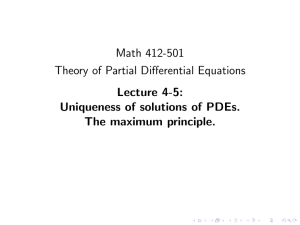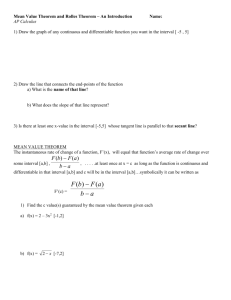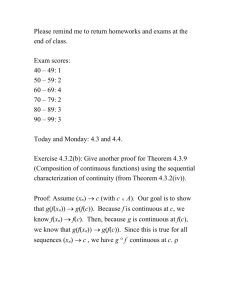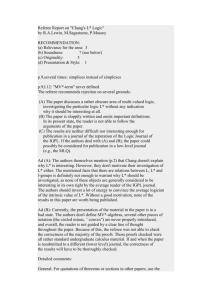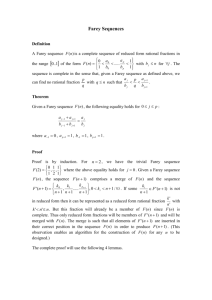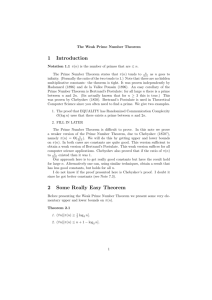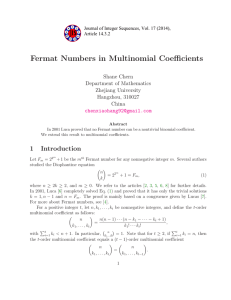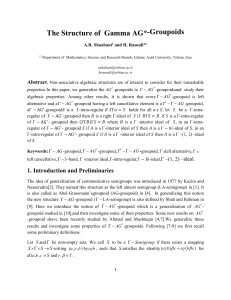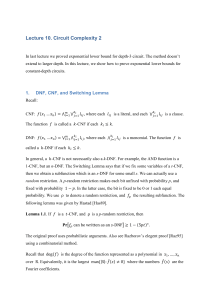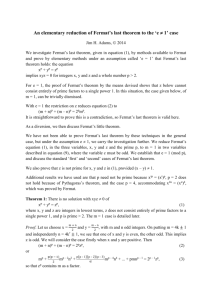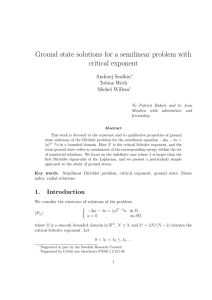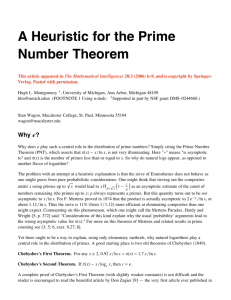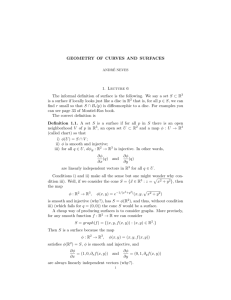values theorem
advertisement
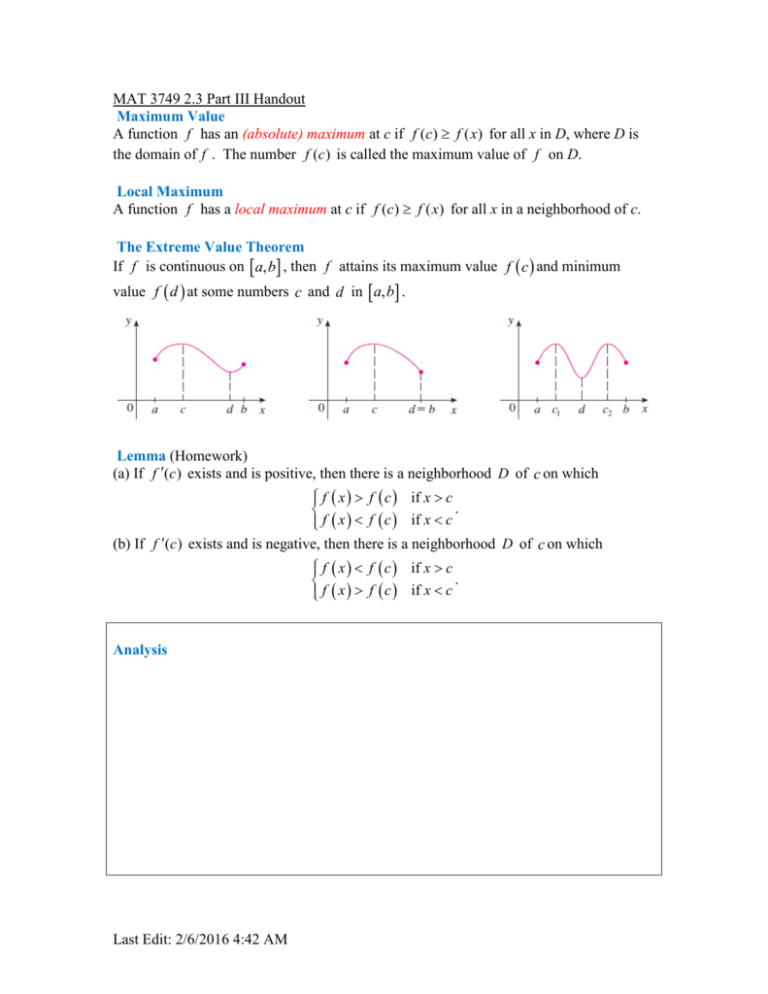
MAT 3749 2.3 Part III Handout Maximum Value A function f has an (absolute) maximum at c if f (c) f ( x) for all x in D, where D is the domain of f . The number f (c ) is called the maximum value of f on D. Local Maximum A function f has a local maximum at c if f (c) f ( x) for all x in a neighborhood of c. The Extreme Value Theorem If f is continuous on a, b , then f attains its maximum value f c and minimum value f d at some numbers c and d in a, b . Lemma (Homework) (a) If f (c ) exists and is positive, then there is a neighborhood D of c on which f x f c if x c . f x f c if x c (b) If f (c ) exists and is negative, then there is a neighborhood D of c on which f x f c if x c . f x f c if x c Analysis Last Edit: 2/6/2016 4:42 AM Fermat’s Theorem If f has a local maximum or minimum at c , and if f (c ) exists, then f (c) 0 . Analysis In light of the lemma, it makes sense to try using a contradiction. Conceptual Diagrams Case 1 f (c) 0 Then, by lemma, there is a neighborhood D of c such that (1) f x f c x c in D and (2) f x f c x c in D . We want to show that f does not have a local maximum at c and f does not have a local minimum at c . In order to show that f does not have a local maximum at c , what exactly do we need to demonstrate? Which of the two conditions, (1) or (2), is relevant? How does this condition implicate the statement above? 2 Proof Suppose f (c) 0 . Case 1 f (c) 0 . Then, by lemma, there is a neighborhood D of c such that (1) f x f c x c in D and (2) f x f c x c in D . Let E be any neighborhood of c . (1) f x f c x c in D E . x c in E such that f x f c f does not have a local maximum at c . (2) f x f c x c in D E . x c in E such that f x f c f does not have a local minimum at c . This is a contradiction to the fact that f has a local maximum or minimum at c . Case 2 f (c) 0 . (similar) Thus, if f has a local maximum or minimum at c , and if f (c ) exists, then f (c) 0 . 3 Rolle’s Theorem Let f be continuous on a, b and differentiable on a, b such that f (a ) f (b) . Then c a, b such that f c 0 . Analysis We have 3 conditions here. They may give us hints of how to approach this problem. On the other hand, we need to make sure we make use of all of them. Conceptual Diagrams After studying the conceptual diagrams, what do you think where we should choose c ? Based on the first condition, which previous result(s) is/are relevant? Do we have enough to get exactly what we want to choose c ? Why? Not the end of the world…at least we get a good starting point. 4 Since f is continuous on a, b , by EVT, f attains its maximum value f and minimum value f at some , a, b . If one of them is local, then we are done. If both are not local, we need to think about what to do. If both are not local, where are and ? What is the implication of these locations? What does this tell you about the function f ? Where to choose c ? Good Job. We have resolve the case when f has absolute maximum / minimum values at both endpoints. Now, let us look carefully how to finish our proof when f has local maximum / minimum values at either or . In the actual proof, it is cleaner to use the cases f f and f f , rather than the equivalent statements above. Suppose f f , how do we know one of and is not one of the end points? We can conclude that at least one of , are in a, b . Let that point be c . 5 Short stop for reality check Which of the 3 conditions that we have not used? Which previous result(s) is/are relevant? Our gut feelings tell us that we need to use Fermat’s Theorem to show that f c 0 . We need to check the two hypotheses before we use it. f has a local maximum or minimum at c . Why? f c exists. Why? We can now conclude that by Fermat’s Theorem, f c 0 . 6 Proof Since f is continuous on a, b , by EVT, f attains its maximum value f and minimum value f at some , a, b . Case 1 f f f is a constant function on a, b . Thus, f x 0, x a, b . Choose any c a, b , we have f c 0 . Case 2 f f Since f (a ) f (b) , , are not both the endpoints. Thus, at least one of , are in a, b . Let that point be c . So, f attains its maximum or minimum value at c a, b . That means f has a local maximum or minimum at c a, b . Since f is differentiable on a, b , f c exists. By Fermat’s Theorem, f c 0 . For all cases, we have proved that c a, b such that f c 0 . 7 The Mean Value Theorem Let f be continuous on a, b and differentiable on a, b . Then c a, b such that f (c) f (b) f (a ) . ba Analysis . 8 Proof f b f a x a and h x f x g x . ba Since g is a polynomial, it is continuous on a, b and differentiable on a, b . Let g x f a So, h is continuous on a, b and differentiable on a, b . Also, h x f x g x f b f a f x f a x a ba f b f a f x ba Now, and f b f a h a f a g a f a f a a a ba 0 f b f a h b f b g b f b f a b a ba 0 By Rolle’s Theorem, c a, b such that f c h c 0 f b f a 0 ba f b f a f c ba 9 Theorem If f ( x) 0 for all x in an interval a, b , then f is constant on a, b . Proof Corollary If f ( x) g ( x) for all x in an interval a, b , then f ( x) g ( x) C on a, b . Proof 10

